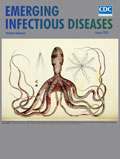
Volume 26, Number 8—August 2020
Research
CrAssphage as a Novel Tool to Detect Human Fecal Contamination on Environmental Surfaces and Hands
Geun Woo Park , Terry Fei Fan Ng, Amy L. Freeland, Vincent C. Marconi, Julie A. Boom, Mary A. Staat, Anna Maria Montmayeur, Hannah Browne, Jothikumar Narayanan, Daniel C. Payne, Cristina V. Cardemil, Aimee Treffiletti, and Jan Vinjé
, Terry Fei Fan Ng, Amy L. Freeland, Vincent C. Marconi, Julie A. Boom, Mary A. Staat, Anna Maria Montmayeur, Hannah Browne, Jothikumar Narayanan, Daniel C. Payne, Cristina V. Cardemil, Aimee Treffiletti, and Jan Vinjé
Abstract
CrAssphage is a recently discovered human gut–associated bacteriophage. To validate the potential use of crAssphage for detecting human fecal contamination on environmental surfaces and hands, we tested stool samples (n = 60), hand samples (n = 30), and environmental swab samples (n = 201) from 17 norovirus outbreaks for crAssphage by real-time PCR. In addition, we tested stool samples from healthy persons (n = 173), respiratory samples (n = 113), and animal fecal specimens (n = 68) and further sequenced positive samples. Overall, we detected crAssphage in 71.4% of outbreak stool samples, 48%–68.5% of stool samples from healthy persons, 56.2% of environmental swabs, and 60% of hand rinse samples, but not in human respiratory samples or animal fecal samples. CrAssphage sequences could be grouped into 2 major genetic clusters. Our data suggest that crAssphage could be used to detect human fecal contamination on environmental surfaces and hands.
Hygienic practices, including disinfection of environmental surfaces, are important to reduce exposure to pathogens that spread through fecal–oral transmission. Thus, monitoring of human fecal contamination and identifying the source of contamination is an important approach to prevent transmission of gastroenteritis viruses for which humans are the only natural host (e.g., human norovirus) (1). Culturable bacteria (e.g., Escherichia coli, Enterococcus spp., and Bacteroides spp.) are widely used as indicators to assess the presence of human fecal contamination of environmental waters (2–5). However, fecal indicator bacteria are not specific to human fecal contamination (6) and have a poor correlation with exposure risk to enteric viruses (4,7–9).
Over the past few decades, several viruses (e.g., human polyomavirus, Aichi virus, norovirus, and human adenovirus) have been studied as human fecal indicators for the detection of sewage-contaminated source and drinking water (10–13). Recently, both norovirus and adenovirus have been suggested as potential biomarkers of viral contamination to assess hygiene status and potential human health risk of contaminated surfaces and hands of affected persons (4,12,14–17). However, the detection of those viruses in indoor environments was relatively rare and inconsistent, making it difficult to estimate indoor hygiene and limiting their applicability for use in both industrial and regulatory settings (12,14–17).
Recently, a new DNA bacteriophage was discovered by computational analysis of publicly accessible human fecal metagenomics data and was named crAssphage, referring to the Cross-Assembly software that was used for its discovery (18). The single-stranded circular DNA genome is 97 kbp in size with 80 predicted open reading frames (ORFs) (18). Genetically, crAssphage are extremely heterogenous and can be grouped into at least 10 different genera (18,19). Various bacteria of the phylum Bacteroidetes have been proposed as the primary hosts of crAssphage, which was supported by recent findings that phage ΦCrAss001 from human feces could be isolated in Bacteroides (20). To date, crAssphage has primarily been detected in human stools and rarely in animals (18,21). In addition, crAssphage can be found at high levels in sewage throughout the year and correlate with the detection of fecal indicators (E. coli, enterococcus, human polyomavirus, and somatic coliphage), suggesting they could be used for monitoring human fecal pollution of water (21–25).
In this study, we aimed to validate the potential use of crAssphage to detect human fecal contamination on environmental surfaces and hands. We tested human stool samples, environmental swab samples, and hand rinse samples collected during norovirus outbreaks, as well as stool samples from persons without acute gastroenteritis (AGE) and saliva and nasal samples from humans with respiratory symptoms. To confirm the specificity of crAssphage for the human gut, we also tested fecal specimens from cats, rats, rhesus monkeys, and husbandry animals (cows, pigs, sheep, and horses).






















.png)











No hay comentarios:
Publicar un comentario